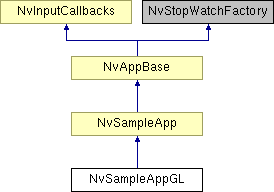NvSampleAppGL Class Reference
Base class for GL sample apps. More...
#include <NvSampleAppGL.h>

Public Member Functions | |
| NvSampleAppGL () | |
| Constructor Do NOT make rendering API calls in the constructor The rendering context is not bound until the entry into initRendering. | |
| virtual | ~NvSampleAppGL () |
| Destructor. | |
| bool | requireExtension (const char *ext, bool exitOnFailure=true) |
| Extension requirement declaration. | |
| bool | requireMinAPIVersion (const NvGLAPIVersion &minApi, bool exitOnFailure=true) |
| GL Minimum API requirement declaration. | |
| virtual void | configurationCallback (NvGLConfiguration &config) |
| GL configuration request callback. | |
| NvAppContextGL * | getGLContext () |
| Return the GL-specific app context structure for easy use in the app. | |
| GLuint | getMainFBO () const |
| Retrieve the main "onscreen" framebuffer; this may actually be an offscreen FBO that the framework uses internally, and then resolves to the window. | |
Detailed Description
Base class for GL sample apps.Member Function Documentation
| virtual void NvSampleAppGL::configurationCallback | ( | NvGLConfiguration & | config | ) | [inline, virtual] |
GL configuration request callback.
This function passes in the default set of GL configuration requests The app can override this function and change the defaults before returning. These are still requests, and may not be met. If the platform supports requesting GL options, this function will be called before initGL. Optional.
- Parameters:
-
[in,out] config the default config to be used is passed in. If the application wishes anything different in the GL configuration, it should change those values before returning from the function. These are merely requests.
| NvAppContextGL* NvSampleAppGL::getGLContext | ( | ) | [inline] |
Return the GL-specific app context structure for easy use in the app.
- Returns:
- Pointer to the GL-specific app context or NULL if not initialized
| GLuint NvSampleAppGL::getMainFBO | ( | ) | const [inline] |
Retrieve the main "onscreen" framebuffer; this may actually be an offscreen FBO that the framework uses internally, and then resolves to the window.
Apps should ALWAYS use this value when binding the onscreen FBO and NOT use FBO ID 0 in order to ensure that they are compatible with test mode, etc. This should be queried on a per-frame basis. It may change every frame
- Returns:
- the GL ID of the main, "onscreen" FBO
| bool NvSampleAppGL::requireExtension | ( | const char * | ext, | |
| bool | exitOnFailure = true | |||
| ) |
Extension requirement declaration.
Allow an app to declare an extension as "required".
- Parameters:
-
[in] ext the extension name to be required [in] exitOnFailure if true, then errorExit is called to indicate the issue and exit
- Returns:
- true if the extension string is exported and false if it is not
| bool NvSampleAppGL::requireMinAPIVersion | ( | const NvGLAPIVersion & | minApi, | |
| bool | exitOnFailure = true | |||
| ) |
GL Minimum API requirement declaration.
- Parameters:
-
[in] minApi the minimum API that is required [in] exitOnFailure if true, then errorExit is called to indicate the issue and exit
- Returns:
- true if the platform's GL[ES] API version is at least as new as the given minApi. Otherwise, returns false
The documentation for this class was generated from the following file: